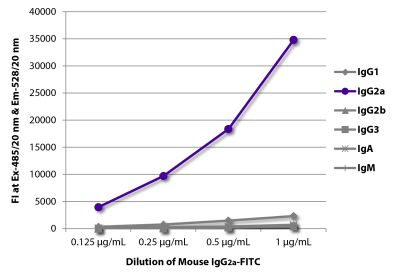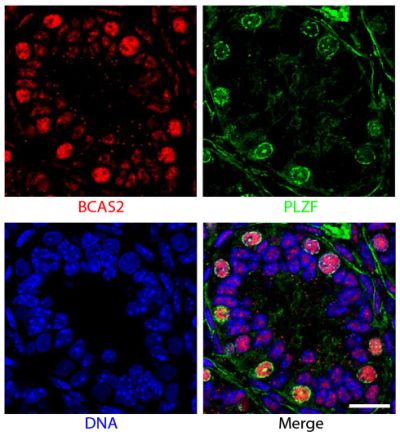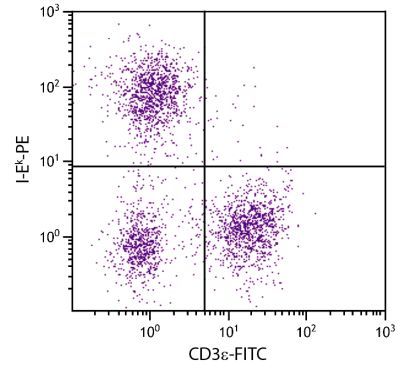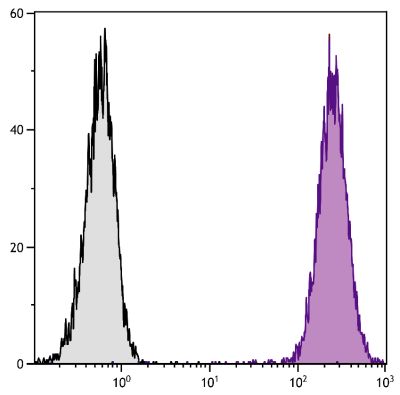Mouse Anti-Mouse H-2Kd/H-2Dd-FITC (34-1-2S)
Cat. No.:
1911-02
FITC Anti-Mouse H-2Kd/H-2Dd antibody for use in flow cytometry and immunocytochemistry assays.
$284.00
| Clone | 34-1-2S |
|---|---|
| Isotype | Mouse (C3H) IgG2aκ |
| Isotype Control | Mouse IgG2a-FITC (HOPC-1) |
| Specificity | Mouse H-2Kd/H-2Dd |
| Alternative Names | MHC Class I |
| Description | The “classical” MHC Class I molecules are histocompatibility antigens encoded by the H-2 gene complex and consist of heterodimers of highly polymorphic α chains noncovalently associated with the invariant β2-microglobulin. These antigens are expressed on most nucleated cells but expression varies on different cell types. MHC Class I molecules present endogenously synthesized peptides to CD8+ T lymphocytes, which are usually cytotoxic T cells. MHC Class I antigens expressed on thymic epithelial cells regulate the positive and negative selection of CD8+ T cells during T cell ontogeny. The monoclonal antibody 34-1-2S binds to a common determinant in the α3 domains of H-2Kd and H-2Dd in the presence or absence of β2 microglobulin. It cross reacts with the α3 domain of H-2Kb. |
| Immunogen | BDF1 mouse splenocytes |
| Conjugate | FITC (Fluorescein) |
| Buffer Formulation | Phosphate buffered saline containing < 0.1% sodium azide |
| Clonality | Monoclonal |
| Concentration | 0.5 mg/mL |
| Volume | 1.0 mL |
| Recommended Storage | 2-8°C; Avoid exposure to light |
| Applications |
Flow Cytometry – Quality tested 3,4 Immunocytochemistry – Reported in literature 3,5 Electron Microscopy – Reported in literature 4 Immunoprecipitation – Reported in literature 2 Complement Mediated Cell Depletion – Reported in literature 3 Blocking – Reported in literature 6 Adhesion – Reported in literature 6 |
| RRID Number | AB_2795497 |
| Gene ID |
14972 (Mouse) 14964 (Mouse) |
| Gene ID Symbol |
H2-K1 (Mouse) H2-D1 (Mouse) |
| Gene ID Aliases | K-f; H-2K; H2-K; H2-D1; H-2K(d); H-2D; H2-D; H2-K1 |
| UniProt ID |
P01902 (Mouse P01900 (Mouse |
| UniProt Name |
HA1D_MOUSE (Mouse) HA12_MOUSE (Mouse) |
Documentation
Certificate of Analysis Lookup
Enter the Catalog Number and Lot Number for the Certificate of Analysis you wish to view
- 1. Ozato K, Mayer NM, Sachs DH. Monoclonal antibodies to mouse major histocompatibility complex antigens. IV. A series of hybridoma clones producing anti-H-2d antibodies and an examination of expression of H-2d antigens on the surface of these cells. Transplantation. 1982;34:113-9. (Immunogen)
- 2. Burgert H, Maryanski JL, Kvist S. "E3/19K" protein of adenovirus type 2 inhibits lysis of cytolytic T lymphocytes by blocking cell-surface expression of histocompatibility class I antigens. Proc Natl Acad Sci USA. 1987;84:1356-60. (IP)
- 3. Lenz A, Heufler C, Rammensee H, Glassl H, Koch F, Romani N, et al. Murine epidermal Langerhans cells express significant amounts of class I major histocompatibility complex antigens. Proc Natl Acad Sci USA. 1989;86:7527-31. (FC, ICC, CMDC)
- 4. Pereira RA, Simmons A. Cell surface expression of H2 antigens on primary sensory neurons in response to acute but not latent herpes simplex virus infection in vivo. J Virol. 1999;73:6484-9. (FC, EM)
- 5. Abendroth A, Simmons A, Efstathiou S, Pereira RA. Infection with an H2 recombinant herpes simplex virus vector results in expression of MHC class I antigens on the surfaces of human neuroblastoma cells in vitro and mouse sensory neurons in vivo. J Gen Virol. 2000;81:2375-83. (ICC)
- 6. Brennen J, Mager D, Jefferies W, Takei F. Expression of different members of the Ly-49 gene family defines distinct natural killer cell subsets and cell adhesion properties. J Exp Med. 1994;180:2287-95. (Block, Adhesion)
See All References






